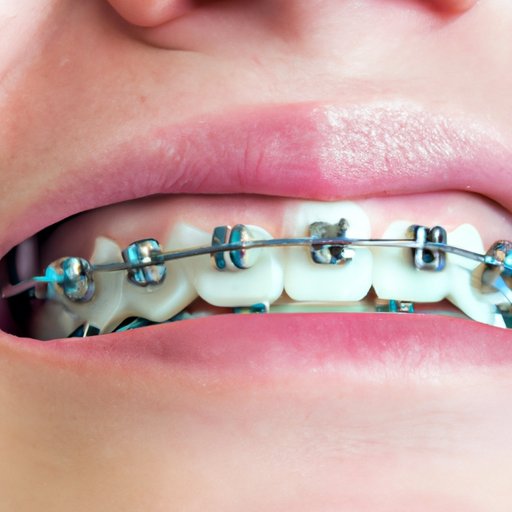
Introduction
For many people, wearing braces is an investment in their dental and emotional health. While the benefits of straighter teeth are undeniable, one of the most common questions asked when considering braces is: how long do I have to wear them?
In this article, we will take a comprehensive look at the timeline for braces, including the factors that can affect how long it takes, the emotional journey of orthodontic treatment, and the importance of life after braces. We will also explore the strategies for potentially speeding up treatment times and celebrating the achievement of a straight smile!

The Average Timeline for Braces: What to Expect
The average orthodontic treatment lasts between 18 and 36 months. However, the exact timeline can vary greatly between individuals, and there are a number of factors that can affect how long you will have to wear braces.
One of the most important factors is the extent of the misalignment of your teeth. The more severe the misalignment or overcrowding, the longer the treatment will typically take. Additionally, keeping up with good oral hygiene practices and attending regular checkups with your orthodontist can help ensure the process goes smoothly and efficiently.
For those considering braces, it’s important to know that the investment in time and money is significant. However, the long-term benefits of a healthier and more confident smile often make it a worthwhile investment.
From Start to Finish: A Braces Timeline
The orthodontic treatment process generally involves several stages, including:
- Consultation and planning stage: This stage includes a comprehensive examination and X-rays to assess the condition of your teeth and determine the best treatment plan for your individual needs.
- Braces installation: This is the stage where the braces are fitted to your teeth.
- Adjustment stage: Throughout the treatment process, you will visit the orthodontist periodically to have your braces adjusted as necessary to ensure the teeth are moving into their new positions properly.
- Finalization stage: Once the teeth are in their proper positions, the braces will be removed, and retainers may be fitted to ensure the teeth stay in place.
The length of time for each stage varies depending on the individual’s orthodontic needs. For example, adjustment stages could occur every 4 to 6 weeks. Your orthodontist will be able to provide a more specific timeline for each stage of the treatment process.
It’s important to make the most out of each stage of treatment by consistently following your orthodontist’s recommendations and taking care of your teeth throughout the process.
Why Wearing Braces Longer Might Be Worth It
Although the average orthodontic treatment lasts between 18 and 36 months, some individuals may benefit from a longer treatment period. In fact, longer treatment times can often lead to better long-term results.
When someone wears braces for an extended period of time, this allows for a more gradual and controlled movement of the teeth. Additionally, taking more time with braces can potentially help to reduce the need for more invasive dental treatments down the line, like tooth extractions or jaw surgery.
Furthermore, there are various orthodontic treatments available today that can shorten the duration of traditional braces treatment. For some patients, Invisalign or other clear aligners can speed up treatment times without compromising on the quality of results.
Patients who have chosen to wear braces for an extended period of time often report that the investment of time and effort was worth it in the end. They are often happier with their results and enjoy the confidence that comes with a perfect smile.
Can You Speed Up the Braces Process?
For those looking to reduce the amount of time spent wearing braces, there are various advanced treatments available today that can speed up the process. These treatments are known as “accelerated orthodontics” and include methods like AcceleDent, Propel, and Wilckodontics.
While these faster methods can be effective, there are also potential downsides to consider. They can be more expensive, and some may require more frequent orthodontic appointments than traditional braces. Additionally, more intensive treatments like Wilckodontics can be more invasive and require prolonged recovery time.
As with any medical procedure, it’s important to carefully weigh the pros and cons of each approach with a trusted professional before making a decision.
How to Make the Most of Your Time with Braces
Wearing braces requires a certain investment of time and effort, but it doesn’t have to be a miserable experience. Here are some tips for making the process more manageable:
- Eat braces-friendly foods to avoid breaking brackets or wires. Avoid foods like popcorn, hard candy, and sticky foods like gum or gummy candies.
- Invest in orthodontic accessories like mouth guards, orthodontic wax, and floss threaders to make treatment easier.
- Practice good oral hygiene, including regular brushing and flossing, to help avoid dental complications like cavities or gum disease.
- Consider the use of accelerated orthodontic treatments, which can help speed up the process.
Remember, braces are a long-term investment in your dental health. Taking care of them and yourself during treatment will help ensure the best possible results.
The Emotional Journey of Wearing Braces
While braces are a physical investment, they can also have a significant emotional impact on patients. Feeling self-conscious or uncomfortable with your smile can take its toll.
It’s important to remember that you’re not alone in your experience. Many others have gone through the same journey, and there are support groups and online forums available to connect with others who are undergoing orthodontic treatment.
Practicing self-care is also important when undergoing any medical treatment. Taking time for yourself, whether it’s through relaxation exercises, journaling, or spending time with friends and loved ones can help relieve the stress and anxiety that can come with wearing braces.
Life After Braces: What to Expect
After the braces are removed, the orthodontic treatment doesn’t stop there! It’s important to take steps to keep your teeth in their new positions and avoid any relapse.
Your orthodontist may recommend a retainer to help keep your teeth in place. Retainers can either be fixed or removable and should be worn as recommended by your orthodontist to avoid any dental issues that may occur due to relapse.
Once the treatment is complete, it’s time to celebrate your new smile! A straighter smile can lead to a boost in self-confidence and improved dental health for years to come.
Conclusion
Wearing braces is a significant investment in your dental health and overall well-being. It’s important to understand the timeline for orthodontic treatment and the factors that can affect it, as well as the tools and techniques available to potentially speed up the process.
Additionally, taking care of yourself during treatment by practicing good oral hygiene, engaging in self-care, and utilizing orthodontic accessories can make for a more manageable journey.
Remember, braces are an investment in a healthier, more confident future. By taking care of them and yourself, you can look forward to a lifetime of beautiful smiles.




